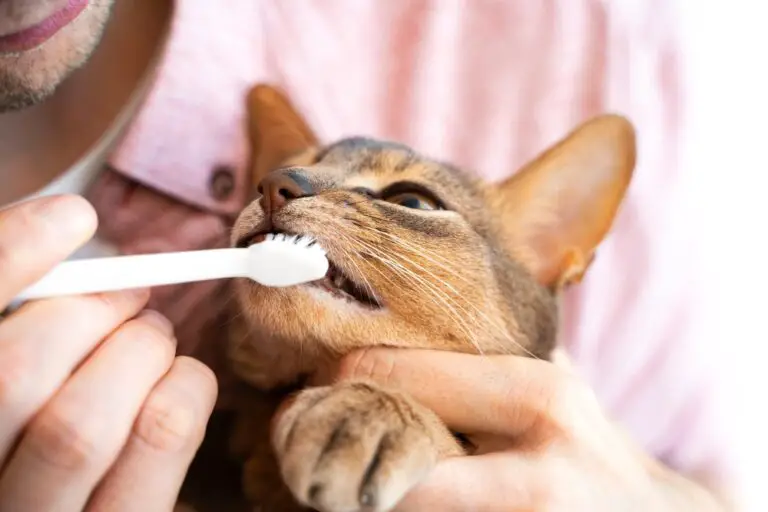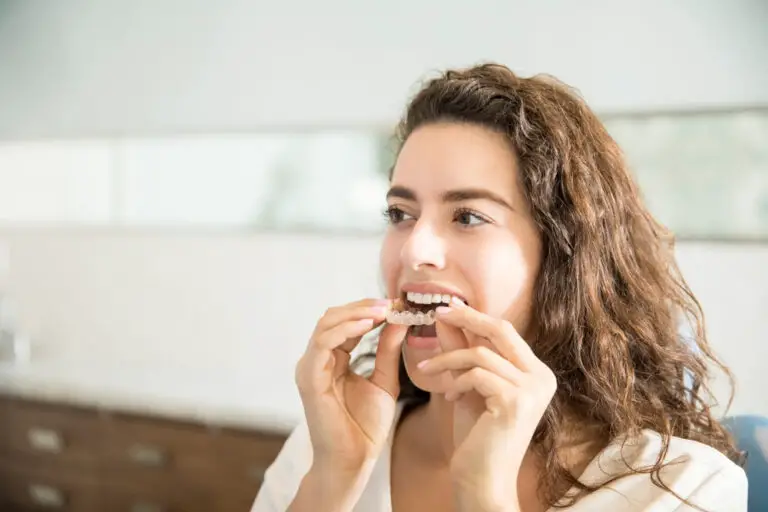Cat bites can be surprising and confusing if you don’t understand the reason behind them. While biting is a natural feline behavior, it’s undesirable when directed at human hands or other body parts. As a cat owner, it’s helpful to know the range of causes, from love to aggression, for your cat putting his teeth on you. With this context, you can take steps to curb biting and help keep interactions with your furry friend pleasant.
When analyzing any behavioral issue, it’s important to start by observing closely and determining why and when the bites occur. For example, does your cat only bite when overstimulated while being petted? Or is it usually playful nips during active times? Once you identify patterns, you can pinpoint the motivation.
While cat bites should never be taken lightly, in most cases they do not imply your cat is dangerous or angry. He may simply be communicating in a natural feline way that conflicts with human ideals. With some behavioral adjustments on both sides, peaceful coexistence is possible. Read on to learn about why cats bite human hands, how to discourage it, and when to seek help.
Why does my cat put his teeth on my hand?
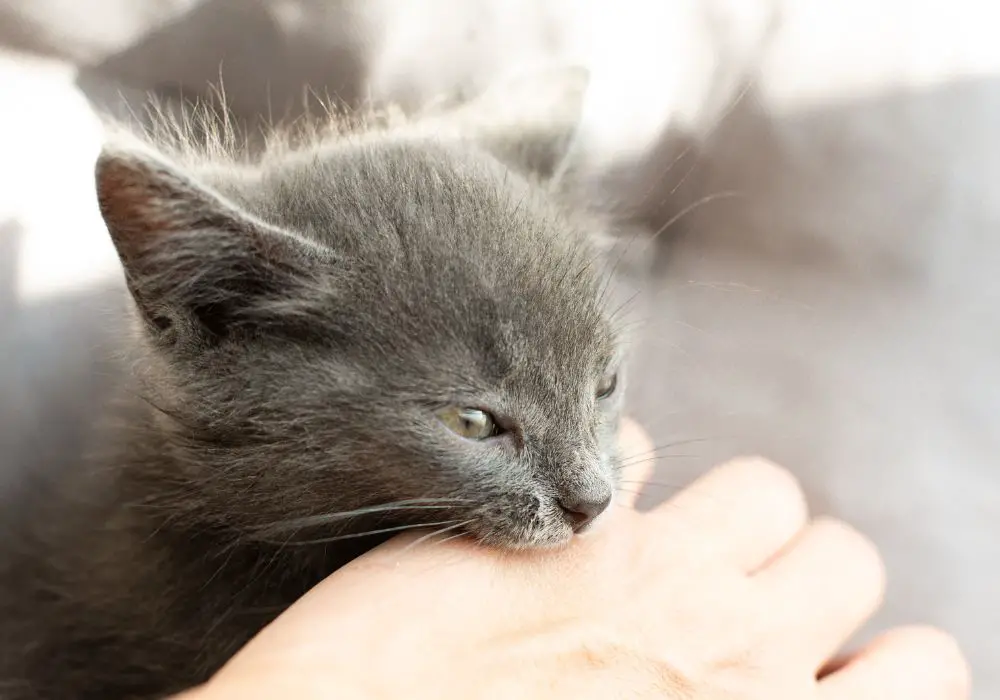
If your cat gently bites or puts his teeth on your hand, there are a few possible reasons for this behavior:
Exploring Through Mouthing
Cats explore the world around them with their mouth. When your cat is a kitten, he may mouth or nibble on you as a form of play or investigative behavior. This is normal for kittens as they learn about their environment through tasting, touching, and “killing”.
Kittens taken from their mother and littermates earlier than 6-8 weeks miss out on important education about controlling their bite pressure when mouthing and playing. A kitten who left mom too early may bite down very hard, causing painful skin-breaking nips. In most cases though, mouthing lessens as the kitten matures.
Love Bites
Some cats will gently bite or mouth as a sign of affection. These “love bites” are usually inhibited – your cat is not actually breaking your skin. One theory is that this mouthing mimics the behavior mother cats do to their nursing kittens, so your cat is regressing back to kittenhood as a way to bond with you.
Other signs your cat is showing affection if he mouths gently include purring, rubbing on you, kneading with his paws, relaxed ears and tail, and slowly blinking eyes. Love bites often happen after enjoyable cuddle or petting sessions. It is one way cats “kiss” their owners and show attachment. As long as the bites don’t progress in pressure or frequency, view them as a compliment.
Redirected Aggression
If your cat is frustrated or aroused by something it cannot access, such as another cat outside the window or prey birds it cannot catch, it may bite the nearest object in lieu of the true target. This is called redirected aggression or displacement aggression, because the cat displaces its aggressive energy onto what is available – often its owner’s hand or arm.
These bites frequently occur when you are holding your agitated cat to try and calm him down. To your cat, though, restraining him adds to the frustration and makes him lash out at the thing closest – you. These bites are often harder and accompanied by behaviors like growls, swats, flattened ears, and lashing tail.
Redirected aggression usually comes on fast and fades quickly once the true trigger is out of sight. The best way to prevent it is learning your cat’s body language and avoiding restraint if he is highly aroused.
Overstimulation
Even loving petting and cuddling can become overstimulating for some cats if done too long or in sensitive areas. Signs of overstimulation include swishing or thrashing tail, pinned back ears, dilated pupils, and skin rippling right before they bite. This occurs because cats have variable sensitivity in being touched depending on the spot.
Belly, rump, base of tail, and around the hips are common overstimulation points. Your cat is saying “enough!” by biting when these areas get rubbed too much. Each cat has unique preferences, so it requires paying close attention to tail, ear, and skin signals to read when overstimulation occurs and cease petting.
Play Biting
Kittens and energetic adult cats may bite hands and feet during active play if those body parts move and act like prey for them to “kill”. These play bites can seem cute but progress to painful punctures. Declawing or physically punishing cats for play biting is ineffective and inhumane.
The better approach is to redirect the biting onto appropriate toys instead of people. Toys involving chasing like feather wands or laser pointers are ideal to allow your cat to act on his instincts in an acceptable way. Given appropriate outlets, most cats eventually outgrow the need to bite people during play.
Medical Causes
Dental disease, neurological issues, wounds or infections, and skin conditions may cause a cat to bite due to feeling pain or general oversensitivity when touched. For example, if petting down the back elicits a bite, your cat may have tender areas or hot spots making them uncomfortable being stroked there.
Any type of mouth pain can also make cats likely to bite because touching their head or accidentally bumping their sore teeth provokes a protective reaction. Cats are masters at hiding illness and pain, so sudden biting deserves a veterinary exam to rule out underlying medical problems.
Lack of Bite Inhibition
Normally, kittens learn to regulate their bite pressure through play with their littermates and correction from mom when biting too hard. Kittens removed from their families too early often bite harder than normal due to poor bite inhibition from that missed education.
These cats are prone to play bites that break skin because no one taught them how sharp their teeth really are. They also can be more easily aroused into biting due to lack of manners. However, bite inhibition can be taught at any age through training, environmental enrichment, and time.
Fear or Anxiety
Fearful, anxious, or easily overwhelmed cats may bite as a protective mechanism. Biting allows them to get something scary (like a human hand) away from them. Situations that evoke fear include:
- Being petted when in an exposed area like being held or on a lap
- Being suddenly touched from behind or while sleeping
- Exposure to new environments, people, or other pets
- Being cornered with no escape route
Bites occur because the cat feels threatened and has no other self-defense. Warning signs include enlarged pupils, pinned back ears, tense body, and agitated tail. Working to boost the cat’s confidence and only approaching when calm can improve this over time.
How to Stop Bites When Petting Your Cat
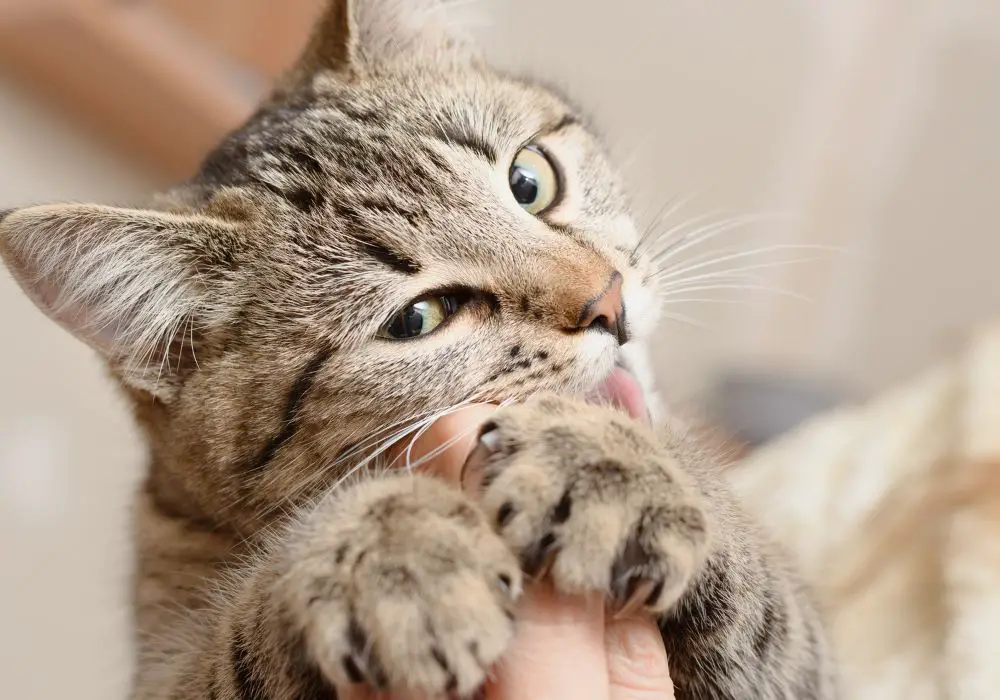
If your cat tends to bite during petting sessions, here are some tips to defuse the situation before teeth touch skin:
- Watch closely for body language signs of overstimulation. Stop petting if you see the tail swishing, ears flattening, skin rippling, or eyes dilating. These all indicate discomfort.
- Heed any meows of protest and shift to shorter, gentler strokes in neutral areas like under the chin rather than sensitive spots.
- Say “ouch!” or yelp loudly in a high pitched voice when your cat does bite, then immediately cease petting and ignore him for a minute or two. This teaches that biting makes the pleasant stimulus of petting stop.
- Have tempting toys like feather wands, crackle balls, or catnip mice nearby to distract or redirect biting. Offering an acceptable outlet lessens the need to bite you.
- If possible, trim nails regularly to lessen scratches if your cat grabs you while biting.
- Start young with bite inhibition training and be consistent. Kittens learn fastest, but adult cats can be trained too. The key is establishing that human skin is off limits.
- Check with your veterinarian to make sure biting is not due to untreated dental problems, arthritis, skin irritation or other medical issues making your cat’s body uncomfortable and prone to lash out if touched.
- For cats prone to redirected aggression, provide escape routes when they seem agitated and avoid restraining or touching them until they calm down. Redirect the energy onto toys once relaxed.
When to Worry About Biting Behavior
Most cat bites are inhibited – your cat applies pressure with their teeth but does not break skin. They are communicating, not attempting to severely injure. However, there are some situations in which biting should not be taken lightly and may signal an underlying issue that needs addressing:
- Biting that seems to escalate in frequency or intensity over time. This can indicate medical problems, heightened stress or frustration, lack of outlet for energy, or lack of consistent training against biting.
- Biting accompanied by aggressive behaviors like swatting, scratching, intense growling, stiff tail, flattened ears and other signs your cat is very upset versus just overstimulated.
- Biting during petting in areas that were previously enjoyed. This often indicates new skin pain or irritation making the cat bite to say “don’t touch there!”
- Experiencing multiple bites within a short time period. This suggests overstimulation and lack of respecting the cat’s boundaries.
- Biting even when your cat appears relaxed and content (e.g. purring, kneading, showing affection). These mixed signals can be confusing and problematic.
- Any bites from a cat with impaired vision, hearing, mobility or cognition. These cats will be more easily startled and prone to defensive biting.
- Bites that seem unpredictable in terms of timing and trigger. Could mean difficulty reading human social cues or handling stimulation.
- Kittens removed from mom/littermates before 6-8 weeks old who play very roughly. They missed out on important bite inhibition education.
While routine gentle mouthing during petting or play may be normal for your individual cat, seek help from your veterinarian or a professional behaviorist for any biting that is worsening, drawing blood, or worrying you. Aggression should never be ignored, but there are humane solutions in most cases. With training, enrichment, and outlets for energy, cats can be taught to keep teeth off human skin.
Tips for Bite Inhibition Training
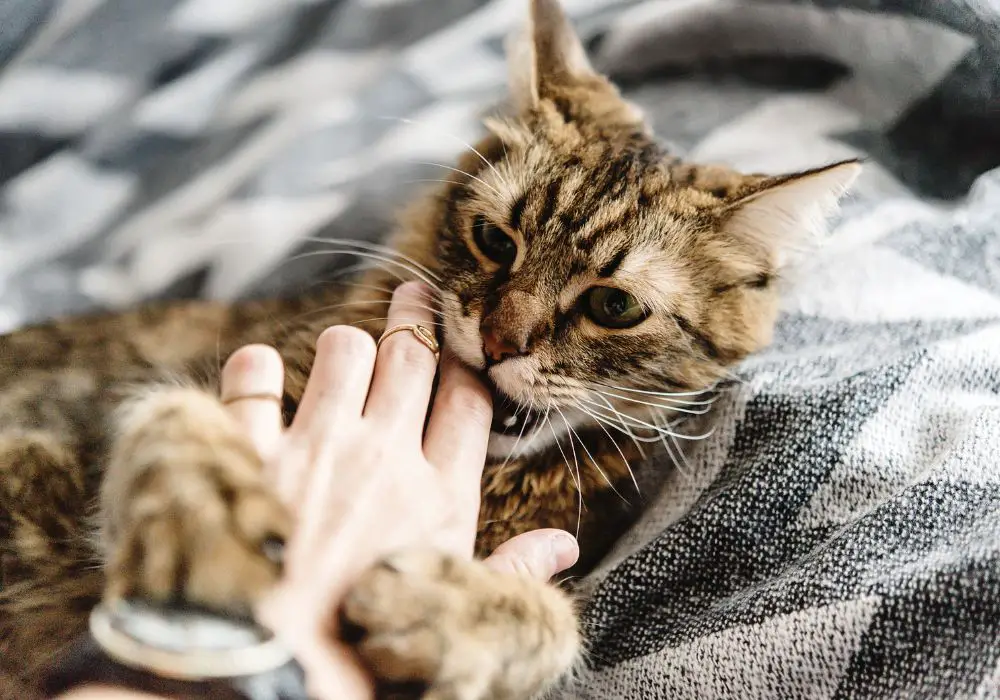
If you want to train a cat against biting people, here are some pointers:
- Start young if possible. Kittens have a prime window for learning appropriate vs. inappropriate biting and their limits. But adult cats can make progress too through consistency.
- Say “ouch!” in a brief but high-pitched, dramatic voice when your cat bites, even if it didn’t hurt. Then immediately ignore them for 60-120 seconds. This teaches that biting makes all fun stop.
- Pet gently and stop petting immediately if your cat seems overstimulated. Avoid prolonged petting of sensitive areas. Use treats, toys, and praise as positive reinforcement instead.
- Redirect any play biting onto appropriate kicker toys, stuffed mice, or toys your cat can “kill”. Vigorous interactive play is an outlet for their primal hunting instincts.
- Avoid scolding, yelling, hitting, squirting or physically punishing the cat. This increases anxiety and stress, often worsening behavior issues.
- Analyze your cat’s schedule and environment. Ensure you have regular interactive play sessions to work off energy. Provide puzzle toys, scratchers, cat trees and other enrichments so they are not bored.
- Try synthetic feline pheromone diffusers or collars to reduce anxiety in frustrated, restless biters and support calmer moods.
- For play-biting kittens, provide kicker toys to “kill”, set up playdates with feline friends, and avoid using hands in play. Human skin should never resemble prey or toys.
- Ensure all family members respond to bites consistently. It takes everyone working together for training methods to stick. Changing behavior takes days or weeks of steady effort.
- Seek help from your veterinarian, a certified behaviorist, or experienced cat trainer if biting remains frequent or severe despite your best efforts. There are many options to try!
While curbing biting takes time, the key is persistence. Prevent the undesirable behavior, redirect to good behaviors instead, use enrichment and play for an outlet, and be consistent. Your cat can keep teeth off human skin and have appropriate toys to “kill”!
Tips for preventing cat bites
| Method | Description |
|---|---|
| Redirect to toys | Have enticing toys on hand to redirect biting onto, like feather wands and soft kickers |
| Ignore after “ouch!” | Say “ouch!”, ignore cat for 1-2 minutes, then calmly interact again |
| More playtime | Increase interactive daily play sessions to 15-20 min to burn energy |
| Pheromones | Try synthetic feline pheromones to reduce anxiety and frustration |
| Pet gently | Avoid overstimulating areas and watch for overstimulation signals |
| Be consistent | Train family to all respond to bites the same way |
| Start young | Begin bite inhibition training during early kittenhood |
| Check medical issues | Rule out dental problems, arthritis, irritation prompting bites |
Frequently Asked Questions
Why does my cat bite me hard while purring?
This is confusing behavior! The purring implies your cat is relaxed and content. But biting can signal overstimulation, even during petting they were enjoying. Gently experiment with where and how long you can pet before it elicits a bite. Cats have unique preferences.
Why does my cat bite me when I stop petting?
Your cat may nip in protest if petting ceases abruptly in the middle of an enjoyable session. Abruptly stopping can be frustrating. Try slowing down petting gradually before fully stopping to avoid startling or annoying your cat.
My cat bites me when she is sitting in my lap, why?
Being confined in a lap can overstimulate some cats, especially with petting added. Biting while on a lap may be a sign your cat feels overhandled or restless. Try letting her relax on your lap with less restraint and petting to see if biting decreases.
Why does my elderly cat suddenly bite a lot?
Senior cats may suddenly start biting more due to medical issues like dental/joint pain or cognitive decline. Vision/hearing loss and disorientation can also prompt defensive biting when startled. Check with your vet to rule out conditions making your elderly cat prone to lash out.
Why does my cat gently take my hand in his mouth and just hold it?
As long as the bite pressure stays gentle and your cat seems relaxed, this type of mouthing and hand-holding is likely an affectionate gesture. Cats sometimes see human hands as surrogate kittens to be carried. It is a sign of trust and contentment.



